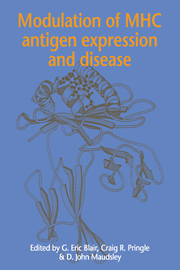Book contents
- Frontmatter
- Contents
- List of contributors
- Preface
- List of abbreviations
- 1 General introduction to the MHC
- 2 Organization of the MHC
- 3 Interactions of cytokines in the regulation of MHC class I and class II antigen expression
- 4 Control of MHC class I gene expression
- 5 Control of MHC class II gene expression
- 6 Modulation of MHC antigen expression by viruses
- 7 Modulation of MHC antigen expression by retroviruses
- 8 Modulation of MHC class I antigen expression in adenovirus infection and transformation
- 9 MHC expression in HPV-associated cervical cancer
- 10 Inhibition of the cellular response to interferon by hepatitis B virus polymerase
- 11 Cellular adhesion molecules and MHC antigens in cells infected with Epstein-Barr virus: implications for immune recognition
- 12 Effect of human cytomegalovirus infection on the expression of MHC class I antigens and adhesion molecules: potential role in immune evasion and immunopathology
- 13 Oncogenes and MHC class I expression
- 14 Mechanisms of tumour cell killing and the role of MHC antigens in experimental model systems
- 15 Manipulation of MHC antigens by gene transfection and cytokine stimulation: a possible approach for pre-selection of suitable patients for cytokine therapy
- 16 Overexpression of MHC proteins in pancreatic islets: a link between cytokines, viruses, the breach of tolerance and insulindependent diabetes mellitus?
- 17 The role of cytokines in contributing to MHC antigen expression in rheumatoid arthritis
- 18 Expression of an MHC antigen in the central nervous system: an animal model for demyelinating diseases
- Index
7 - Modulation of MHC antigen expression by retroviruses
Published online by Cambridge University Press: 11 September 2009
- Frontmatter
- Contents
- List of contributors
- Preface
- List of abbreviations
- 1 General introduction to the MHC
- 2 Organization of the MHC
- 3 Interactions of cytokines in the regulation of MHC class I and class II antigen expression
- 4 Control of MHC class I gene expression
- 5 Control of MHC class II gene expression
- 6 Modulation of MHC antigen expression by viruses
- 7 Modulation of MHC antigen expression by retroviruses
- 8 Modulation of MHC class I antigen expression in adenovirus infection and transformation
- 9 MHC expression in HPV-associated cervical cancer
- 10 Inhibition of the cellular response to interferon by hepatitis B virus polymerase
- 11 Cellular adhesion molecules and MHC antigens in cells infected with Epstein-Barr virus: implications for immune recognition
- 12 Effect of human cytomegalovirus infection on the expression of MHC class I antigens and adhesion molecules: potential role in immune evasion and immunopathology
- 13 Oncogenes and MHC class I expression
- 14 Mechanisms of tumour cell killing and the role of MHC antigens in experimental model systems
- 15 Manipulation of MHC antigens by gene transfection and cytokine stimulation: a possible approach for pre-selection of suitable patients for cytokine therapy
- 16 Overexpression of MHC proteins in pancreatic islets: a link between cytokines, viruses, the breach of tolerance and insulindependent diabetes mellitus?
- 17 The role of cytokines in contributing to MHC antigen expression in rheumatoid arthritis
- 18 Expression of an MHC antigen in the central nervous system: an animal model for demyelinating diseases
- Index
Summary
Introduction
The growth cycles and oncogenic properties of the murine and human retroviruses are inextricably linked to the immune system. Those viruses that cause leukaemias, lymphomas or immunodeficiencies do so by infecting and often activating immune cells. Conversely, those retroviruses that induce solid tumours must evolve ways to aid the host cell in evading the cellular immune system. One major molecular mechanism by which these retroviruses can either activate or evade the immune system is by control of MHC class I antigen expression in the cells they infect. An effect of murine retrovirus infection on MHC antigen expression was first suspected in the late 1970s, when it was observed that thymocytes obtained from animals several weeks after infection with leukaemia viruses appeared to express higher levels of MHC class I antigens than thymic cells from control animals. Conversely, down-regulation of MHC expression on solid tumours induced by oncogene-containing (sarcoma) retroviruses had also been observed. Because of the experimental constraints of these in vivo systems, however, proof of a causal relationship between retrovirus infection and MHC regulation was lacking. More recent studies have demonstrated a direct action of retroviruses on MHC gene regulation and have begun to elucidate the ways in which these compact viruses, with only 6000–10 000 bases of coding sequence, regulate the histocompatibility antigen expression of their host cells.
Murine leukaemia virusesy
The murine retroviruses can be broadly divided into two classes: the leukaemia viruses and the sarcoma viruses.
- Type
- Chapter
- Information
- Modulation of MHC Antigen Expression and Disease , pp. 150 - 191Publisher: Cambridge University PressPrint publication year: 1995
- 4
- Cited by



